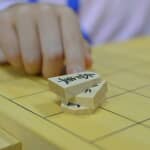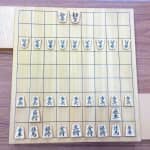Shogi 29 January 2020
Things That Shogi Beginner Children Often Get Confused with: #9 Tend to Use Only Hisha to Attack
*Please note that the Kanji numbers in pictures are spelled in English in the text. The following Shogi boards have a face with files (vertical rows) numbered 1 through 9, from right to left, and ranks (horizontal rows) designated with Kanji characters, “一” (One) to “九” (Nine), from top to bottom. On the other hand, in the text, each Kanji character is replaced with an alphabet, from “a” to “i”: “一” with “a”, “二” with “b”, … and “九” with ”i”.
What Happened? I Can’t Attack…
Hisha (Rook) is a popular piece with children because it moves a lot at a time and it’s easy to find a square to which Hisha (Rook) moves. Once they learn Hisha (Rook) is a major piece for attacking, they can use it to attack.
Now, there is a problem. Even though children move Fu (Pawn) placed ahead of Hisha (Rook) to make a path for the Hisha (Rook), they often move it forward and then sideways to attack from a different file rather than the second file. Do you think the attack shown in the picture below will work well?

Unfortunately, I have to say it won’t work. If you move Hisha (Rook) to the square of 5c and promote it, it will be taken by your opponent’s Gyoku (King).
In the situation of Picture #1, when you understand that you won’t be able to promote Hisha (Rook) on the fifth file, you may move it to the right or the left to find a good place for attacking. You will notice that it’s no use trying to attack from any file other than the second, getting hampered by your opponent’s defensive pieces (△G-2b against ▲R-1f, etc.). Hisha (Rook) is a major attacking piece, but it can’t play its role by itself.
Risk of Becoming an Easy Target
There is another risk of placing Hisha (Rook) ahead of Fu (Pawn).
Look at the picture below. What is the aim of the handicap giver in this situation?

His/Her aim is to capture your Hisha (Rook). If he/she move Fu (Pawn), △P-7e, the Hisha (Rook) will lose the square to move to and be taken by Fu (Pawn).
Hisha (Rook) can move a lot, both horizontally and vertically, at one time. Even so, if it doesn’t have enough space to move, you can’t make the most use of its advantage. Remember it’s risky for Hisha (Rook) to be placed ahead of Fu (Pawn).
How to use Hisha (Rook)
You may well wonder how you use Hisha (Rook).
Point 1. Move Backward
After pushing Fu (Pawn) ahead of Hisha (Rook), exchange pieces of Fu (Pawn).

In the above situation, move Hisha (Rook) back to its initial position, 2h. I assume you want to move it back one or two ranks and then move it sideways. However, stay patient! Don’t move it horizontally, but move it back to the square of 2f, which is an important basic idea you should remember.
Point 2. Support from the Back
It’s understandable that you almost moved Hisha (Rook) to the front to attack, knowing it’s a major attacking piece. Use it to support the other pieces from behind. Pieces in the front are under threat from being captured. Place low-value pieces in the front and use them for attacking.
Comparing two situations below, which is more tactical?

The answer is the situation in the right picture. The following moves in the right picture will make a successful attack: ▲-2c, △G-2c, and ▲R-2c+. On the other hand, when you place Kyo (Lance) on the square of 2i, you can break the opponent’s camp with Hisha (Rook), but it will be taken and the attack doesn’t work: ▲R-2c+, △G-2c, and ▲L-2c. You lose more than gain.
As a reference, I show you the next picture. It shows you a style of attacks named Bougin in Japanese. In this style, Gin (Silver) advances along with its Hisha‘s (Rook’s) file. You keep Gin (Silver) moving to swap it for Kin (Gold) and break your opponent’s camp, which are the aims of this attack.

After the above situation, two players will make moves as follows: ▲P-2d*, △P-2d, and ▲S-2d. Then you will move and promote Gin (Silver), ▲S-2c+ to aim at promoting Hisha (Rook).
This attack technique, which is one of Shogi basics, is very common for both professional and amateur players.
When in doubt, use this technique and attack in this style.
For more details about Bougin, please read our textbook, “Shogi Lesson Book for Beginners Vol. 3“.
Let’s apply what you have learned so far into the endgame phase.
In the following situation, which piece should be promoted?

In the above situation, again, Hisha (Rook) should support other pieces and move Fu (Pawn), ▲P-6b+. Gyoku (King) will move to the square of 8a, △K-8a, and your To-Kin (Promoted Pawn) to the square of 7b, ▲+P-7b. You can corner Gyoku (King). When you move Hisha (Rook) first, ▲R-6b+, there is no way against Gyoku (King) moving, △K-8a.
In Conclusion,
Even though Hisha (Rook) has strong power, it doesn’t work well when it’s used in the wrong way.
Those who have problems with using Hisha (Rook), I would suggest keeping in mind to have horizontal and vertical ways for Hisha (Rook) to move through and have Hisha (Rook) as a piece who supports other pieces from behind.



